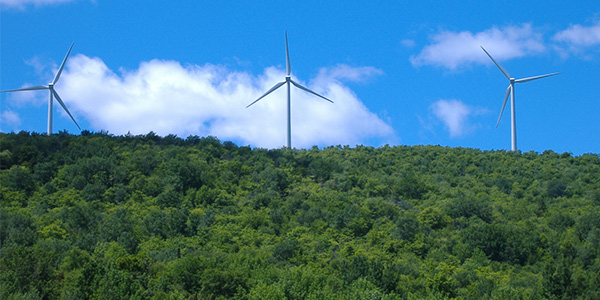Maine could benefit from the designation of Competitive Renewable Energy Zones (CREZ) for building onshore wind to meet its 2030 renewable portfolio standard of 80%, according to a study released last week by Gov. Janet Mills’ Energy Office.
By following the example of Texas’ CREZ process, the state could unlock the potential of significant remote wind resources that are inaccessible absent investments in transmission, according to the “Renewable Energy Goals Market Assessment.” A 2019 law that updated the state’s RPS called for the study, which was sponsored by the Energy Office and conducted by Energy & Environmental Economics (E3) and Applied Economics Clinic.
The designation of two CREZ, one in the western part of the state and one in the north, would send a signal to developers that certain wind resources are critical to meeting the RPS, the study said. Under the CREZ approach, the state could reduce developer uncertainty by completing transmission upgrades in the designated zones in advance of wind farm construction, it said.
The study suggested that the state issue two requests for proposals for each zone, with one proposal targeting transmission development and another targeting resource development.
A new study from the Maine Energy Office said the state could meet its 2030 RPS by establishing CREZ, in which wind farms like the 42-MW Mars Hill project, seen here in Northern Maine, could be developed. | CC BY-SA 2.0, via Wikimedia Commons
A CREZ approach in Maine, however, would require an additional study of population and environmental barriers to land development, the study said.
The purpose of the market assessment is to support policymaking on the path to achieving the state’s renewable portfolio standard. The Energy Office is accepting comments on the study through Friday.
Finding 800 MW
The study determined that Maine already has either built or procured enough resources to meet its renewables standard through 2026. After that, the state will need to bring online at least 800 MW of new resources to meet the 80% requirement in 2030. Wind resources in western and northern Maine, according to the study, would provide a low-cost option for compliance.
Six scenarios in the study show pathways for meeting the 2030 requirement. Under a least-cost scenario, for example, new onshore wind development would fulfill the 800-MW need. That development, however, would only be possible with transmission upgrades.
The study’s review of transmission constraints in the western and northern regions showed that, with grid upgrades, the two zones could support 360 and 498 MW, respectively, of new onshore wind capacity in 2030.
Offshore Wind Scenario
Maine could turn entirely to offshore wind as an alternative to onshore wind and transmission development to meet the 80% requirement.
Under the study’s high OSW scenario, up to 1 GW of offshore capacity would be interconnected to Maine’s grid by 2030. The need for new onshore wind capacity would be pushed out to 2035, and the first transmission upgrades would not need to be completed until 2040. A high offshore wind option would require additional analysis of Maine’s grid to understand the implications of adding offshore capacity, the study said.
Existing Transmission
To understand how Maine could meet its 80% requirement without grid upgrades and with a mix of resources, the study identified three resources that could be brought online by 2030 with existing infrastructure. Under a no-grid-upgrades scenario, Maine could bring online 500 MW of offshore wind, 260 MW of distributed generation and 200 MW of onshore wind.
The 200 MW of onshore wind would need to be developed in southern Maine, where the study determined the existing transmission system has available capacity.


